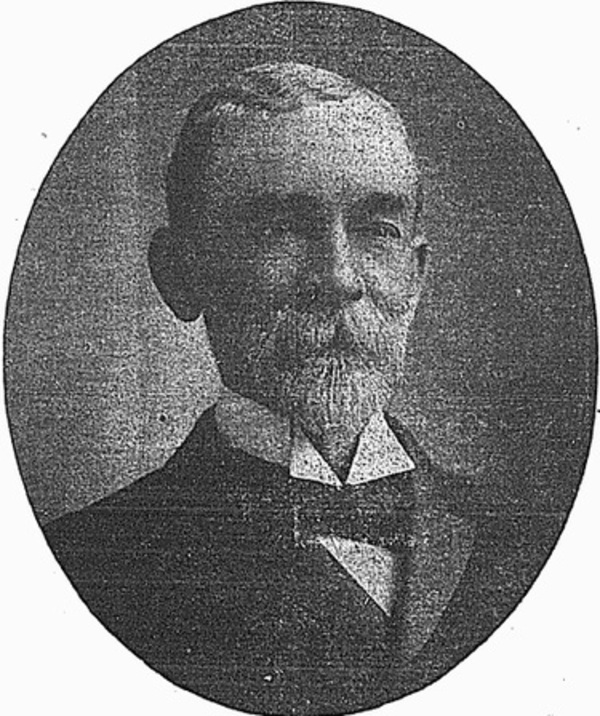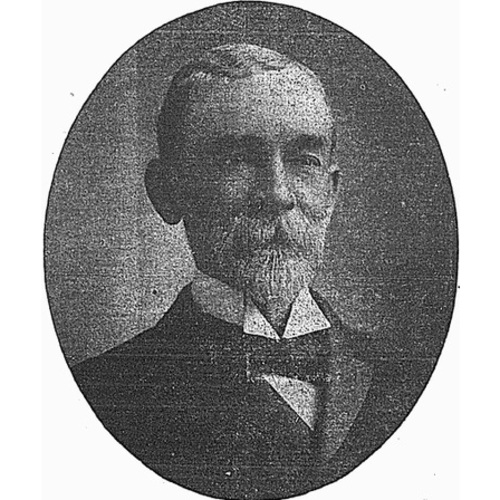
Source: Link
MOORE, JOHN THOMAS, accountant, businessman, and politician; b. 3 July 1844 in Markham Township, Upper Canada, son of William Kerr Moore and Isabella Moore; m. first 23 Aug. 1871 Annie Addison in Galt (Cambridge), Ont., and they had a daughter and two sons; m. secondly 3 June 1914 Alice Rogers Forbes, a widow, in Montreal; d. 5 June 1917 in Toronto.
John T. Moore attended school in Berlin (Kitchener), Upper Canada, where his family had moved shortly after his birth and where his father became a successful businessman. After serving as deputy registrar of Waterloo County from 1864 to 1870, he went to Toronto and tried medicine and law, obtaining some formal training in both. Ambitious and impatient, he abandoned these endeavours, drifted into insurance work, and qualified as an accountant (in 1890–91 he would be president of the Institute of Chartered Accountants of Ontario). He was active in Metropolitan Church, the major Methodist church in the city, and his church connections were the source of his main interest in later life, the Canadian northwest.
In 1880 the Missionary Society of the Methodist Church of Canada sent its secretary-treasurer, the Reverend Alexander Sutherland*, to evaluate the need for further missionary work in the northwest. He concluded that the evangelical Christian churches had an obligation and a real opportunity to achieve a spiritual regeneration of society based in this region. He interested other prominent Methodists in his project, and together they formed the Saskatchewan Land and Homestead Company Limited (SLHC) in 1882, with John Jacob Withrow* as president and Moore – then a senior clerk with Scott and Walmsley, insurance brokers, in Toronto – as managing director. Sent to the northwest that summer, Moore returned with a fervent optimism for the region that lasted throughout his life.
The company secured three big grants of land: at Crescent Lake (Sask.), at the “elbow” of the North Saskatchewan River, and along the Red Deer River (Alta). Moore led the first group of colonists to Crescent Lake by special train on 27 March 1883. In 1884 he was in England, lecturing on Canada and recruiting settlers; that same year he published in Toronto The settlers’ guide to homesteads in the Canadian north-west, a panegyric on the company’s locations. Within a year, however, the North-West rebellion had effectively ended immigration in the near term. Land sales did not improve in the 19th century, and the directors appear to have redeemed much of their shareholdings for land. Although Moore continued to work at development, the trickle of business convinced him that he needed some other means of support. The housing boom of the 1880s in Toronto provided the opportunity. In 1890 Moore and a group formed the Toronto Belt Land Corporation Limited to market the city’s new suburbs: Moore Park, Forest Hill, Fairbank, and Fairbank Junction. Demand was grossly overestimated, however, and the corporation was bankrupt before the Toronto Belt Line Railway, which provided access to the suburbs and of which Moore was vice-president, was completed in 1892.
By the turn of the century the real estate market was strong in the west. In 1901 Moore moved his base of operations for SLHC from Toronto to Red Deer, although his family continued to live in Moore Park. Yet the next year he announced that the company had been wound up, just as the market was peaking. The apparent cause was foreclosure on a mortgage by the estate of Edward Leadlay, one of SLHC’s founders; in fact, Moore was attempting to take over the company’s lands himself. Charged with fraud, he was exonerated in 1905 but was eventually ousted from the company’s affairs.
Moore and other Red Deer businessmen had begun the Western Telephone Company in 1902 and the Western General Electric Company in 1903; both firms obtained a 25-year franchise from the town council. Moore reorganized them in 1904 as the Western General Electric Company Limited, which began supplying electricity later that year and telephone services in 1905. Moore subsequently became a supporter of government ownership of the telephone system. By the time the province entered the business in 1907, Western General Electric with its better technology and lower rates was winning its local competition with the Bell Telephone Company of Canada. Its telephone interests would be sold to the province in 1920.
Among Moore’s other interests were the Alberta Advocate (Red Deer), of which he was publisher and editor in 1905–6, and the Alberta Central Railway, which he served first as a director and then as president. Incorporated in 1901, the railway was originally designed by Moore to service the SLHC lands to the east and west of Red Deer. In its first few years, however, it did little but seek extensions of its charter and government subsidies. In 1908 the federal Liberals came through with a subsidy to build the line from Red Deer to Rocky Mountain House and the coalfields to the west, and two years later Sir Wilfrid Laurier drove the first spike. In the meantime Moore had used the prospect of railway work as an incentive in election campaigns. In 1905, when Alberta became a province, he was elected to the provincial legislature for Red Deer. He had had some previous political experience as an alderman in Toronto in 1883–84. He was considered a powerful orator, and his speech urging the advantages of Red Deer as the capital of the new province was regarded by contemporaries as his greatest. A supporter of the Liberal government of Alexander Cameron Rutherford*, he was defeated in the election of 1909.
Moore and his family had left Toronto in 1905, and their home, Avoca Vale, had been leased and subsequently sold. After the death of his wife Annie in 1911, Moore returned to Moore Park, built a second Avoca Vale, and grew roses. His initial order, from Ireland, was for 15,000 bushes, which were tended by a full-time gardener from Scotland. Moore was honorary president of the Rose Society of Ontario when it was organized in 1913 and its principal financial support. In 1914 he claimed to have 100,000 blooms in his garden. The new Avoca Vale was destroyed by fire just before Moore married again in 1914, but the roses were saved. Moore had lost much of his optimism and exuberance, however. Contemporaries thought him a shadow of his former self. After a year’s illness he succumbed to a heart attack in 1917.
He died much as he had lived, litigiously and in financial difficulties. His will is a classic Moore document, bad tempered and petty. His new wife inherited everything, subject to a minor legacy to his daughter. The sons got nothing. Since all his assets were assigned for the benefit of his creditors – an assignment his children unsuccessfully sued to prevent – the will had little effect. On the other hand, Red Deer flourished and the Avoca Vale roses bloomed.
John Thomas Moore is the author of The settlers’ guide to homesteads in the Canadian north-west (Toronto, 1884).
AO, RG 22-305, no.34423; RG 80-5-0-80-5-0-19, 18: f.216. Red Deer and District Arch. (Red Deer, Alta), C-IV-2 (Saskatchewan Land and Homestead Company fonds); S-II-3-5 (E. L. Meeres fonds), boxes III–V. Globe, 25 Aug. 1871, 11 Sept. 1911, 6 June 1914, 6 June 1917. Red Deer Advocate, 15 May 1914, 4 Feb. 1967. World (Toronto), 6 June 1917. Donna Baker, Moore Park: an introductory history ([Toronto], 1984). B. E. Batchelor, “The agrarian frontier near Red Deer and Lacombe, Alberta, 1884–1914”
Cite This Article
Philip Creighton, “MOORE, JOHN THOMAS,” in Dictionary of Canadian Biography, vol. 14, University of Toronto/Université Laval, 2003–, accessed December 20, 2025, https://www.biographi.ca/en/bio/moore_john_thomas_14E.html.
The citation above shows the format for footnotes and endnotes according to the Chicago manual of style (16th edition). Information to be used in other citation formats:
| Permalink: | https://www.biographi.ca/en/bio/moore_john_thomas_14E.html |
| Author of Article: | Philip Creighton |
| Title of Article: | MOORE, JOHN THOMAS |
| Publication Name: | Dictionary of Canadian Biography, vol. 14 |
| Publisher: | University of Toronto/Université Laval |
| Year of publication: | 1998 |
| Year of revision: | 1998 |
| Access Date: | December 20, 2025 |



